International Business Environment: IKEA's Global Expansion Strategy
VerifiedAdded on 2020/01/23
|11
|4201
|347
Report
AI Summary
This report analyzes IKEA's international business environment and global expansion strategy, specifically focusing on its potential expansion into the Indian market. It examines various market entry strategies, including exporting, franchising, licensing, and joint ventures, considering their advantages and disadvantages in the context of IKEA's objectives. The report references models like the Ansoff matrix and the Uppsala model to evaluate growth options and assess the suitability of different approaches. The analysis considers factors such as cost, market competition, brand recognition, and the specific characteristics of the Indian market. The report concludes with a recommendation for IKEA's most effective market entry strategy, considering the company's goals of cost control, sales enhancement, and long-term growth in the Asian market.
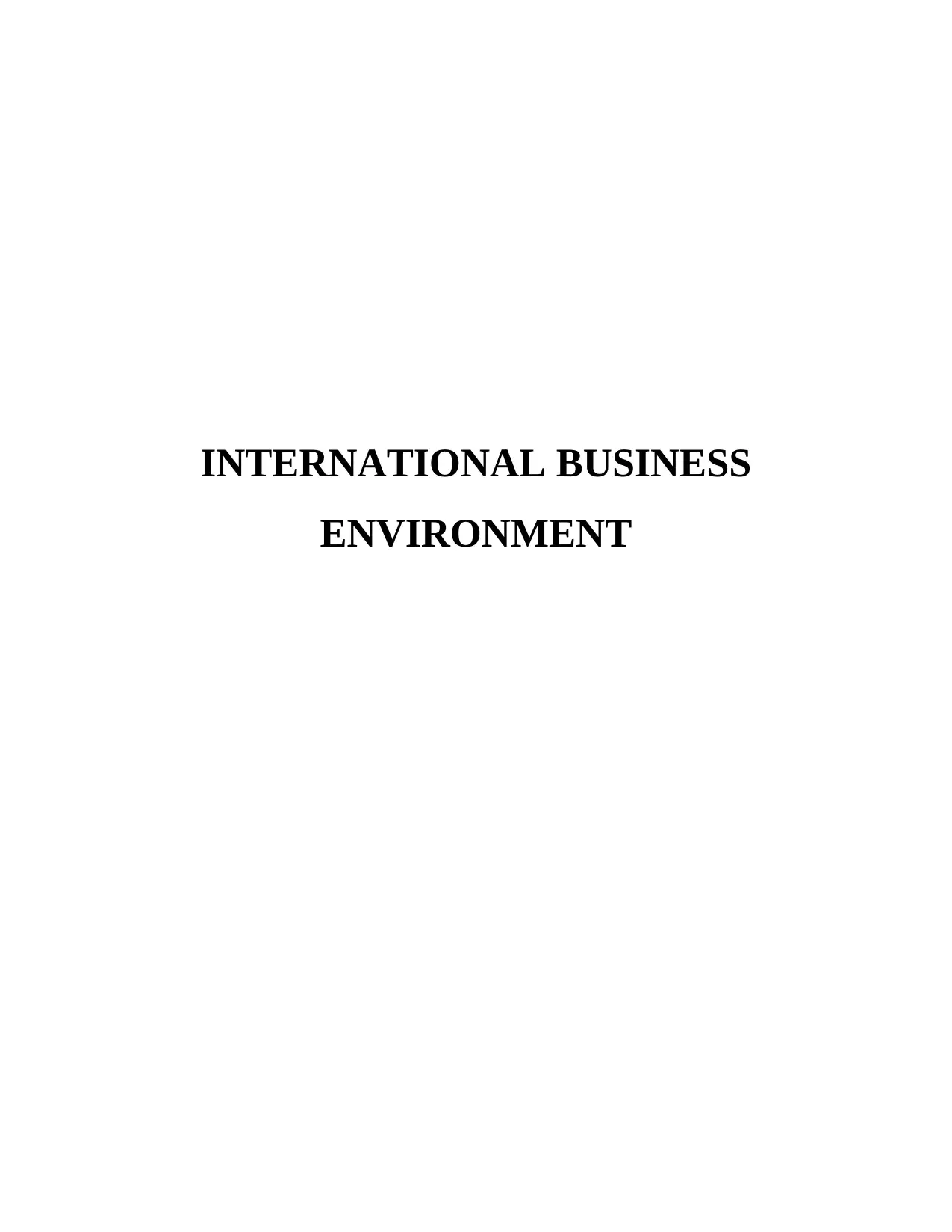
INTERNATIONAL BUSINESS
ENVIRONMENT
ENVIRONMENT
Paraphrase This Document
Need a fresh take? Get an instant paraphrase of this document with our AI Paraphraser
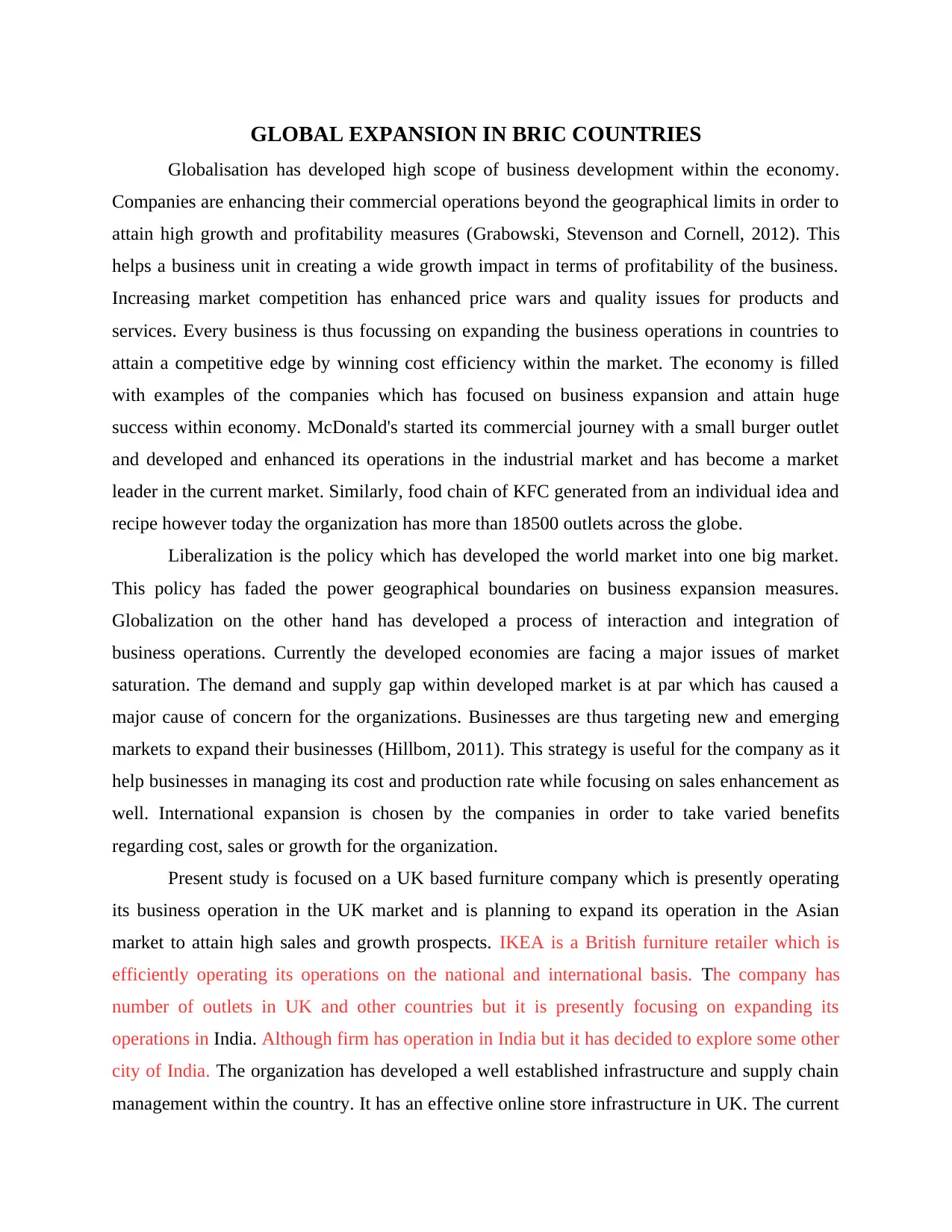
GLOBAL EXPANSION IN BRIC COUNTRIES
Globalisation has developed high scope of business development within the economy.
Companies are enhancing their commercial operations beyond the geographical limits in order to
attain high growth and profitability measures (Grabowski, Stevenson and Cornell, 2012). This
helps a business unit in creating a wide growth impact in terms of profitability of the business.
Increasing market competition has enhanced price wars and quality issues for products and
services. Every business is thus focussing on expanding the business operations in countries to
attain a competitive edge by winning cost efficiency within the market. The economy is filled
with examples of the companies which has focused on business expansion and attain huge
success within economy. McDonald's started its commercial journey with a small burger outlet
and developed and enhanced its operations in the industrial market and has become a market
leader in the current market. Similarly, food chain of KFC generated from an individual idea and
recipe however today the organization has more than 18500 outlets across the globe.
Liberalization is the policy which has developed the world market into one big market.
This policy has faded the power geographical boundaries on business expansion measures.
Globalization on the other hand has developed a process of interaction and integration of
business operations. Currently the developed economies are facing a major issues of market
saturation. The demand and supply gap within developed market is at par which has caused a
major cause of concern for the organizations. Businesses are thus targeting new and emerging
markets to expand their businesses (Hillbom, 2011). This strategy is useful for the company as it
help businesses in managing its cost and production rate while focusing on sales enhancement as
well. International expansion is chosen by the companies in order to take varied benefits
regarding cost, sales or growth for the organization.
Present study is focused on a UK based furniture company which is presently operating
its business operation in the UK market and is planning to expand its operation in the Asian
market to attain high sales and growth prospects. IKEA is a British furniture retailer which is
efficiently operating its operations on the national and international basis. The company has
number of outlets in UK and other countries but it is presently focusing on expanding its
operations in India. Although firm has operation in India but it has decided to explore some other
city of India. The organization has developed a well established infrastructure and supply chain
management within the country. It has an effective online store infrastructure in UK. The current
Globalisation has developed high scope of business development within the economy.
Companies are enhancing their commercial operations beyond the geographical limits in order to
attain high growth and profitability measures (Grabowski, Stevenson and Cornell, 2012). This
helps a business unit in creating a wide growth impact in terms of profitability of the business.
Increasing market competition has enhanced price wars and quality issues for products and
services. Every business is thus focussing on expanding the business operations in countries to
attain a competitive edge by winning cost efficiency within the market. The economy is filled
with examples of the companies which has focused on business expansion and attain huge
success within economy. McDonald's started its commercial journey with a small burger outlet
and developed and enhanced its operations in the industrial market and has become a market
leader in the current market. Similarly, food chain of KFC generated from an individual idea and
recipe however today the organization has more than 18500 outlets across the globe.
Liberalization is the policy which has developed the world market into one big market.
This policy has faded the power geographical boundaries on business expansion measures.
Globalization on the other hand has developed a process of interaction and integration of
business operations. Currently the developed economies are facing a major issues of market
saturation. The demand and supply gap within developed market is at par which has caused a
major cause of concern for the organizations. Businesses are thus targeting new and emerging
markets to expand their businesses (Hillbom, 2011). This strategy is useful for the company as it
help businesses in managing its cost and production rate while focusing on sales enhancement as
well. International expansion is chosen by the companies in order to take varied benefits
regarding cost, sales or growth for the organization.
Present study is focused on a UK based furniture company which is presently operating
its business operation in the UK market and is planning to expand its operation in the Asian
market to attain high sales and growth prospects. IKEA is a British furniture retailer which is
efficiently operating its operations on the national and international basis. The company has
number of outlets in UK and other countries but it is presently focusing on expanding its
operations in India. Although firm has operation in India but it has decided to explore some other
city of India. The organization has developed a well established infrastructure and supply chain
management within the country. It has an effective online store infrastructure in UK. The current
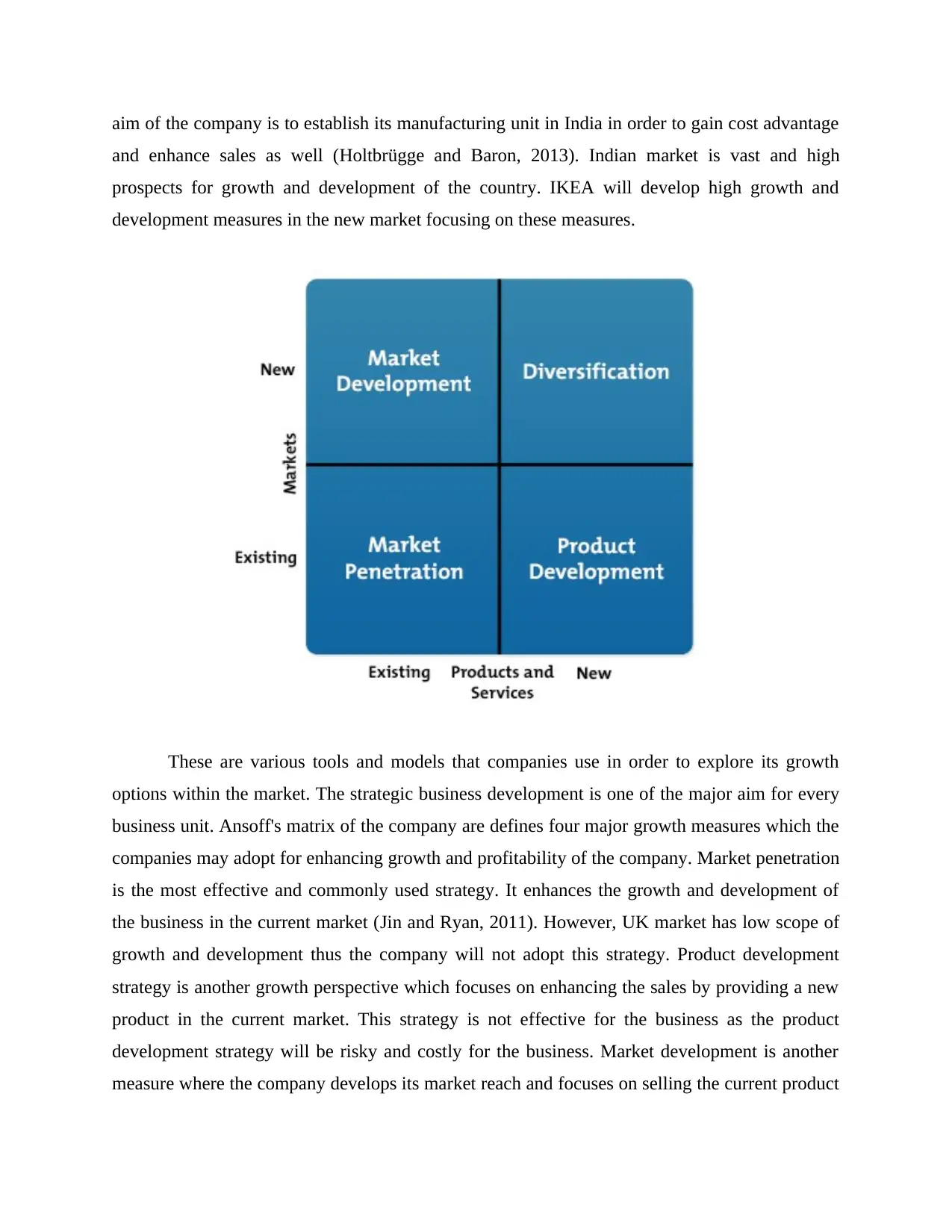
aim of the company is to establish its manufacturing unit in India in order to gain cost advantage
and enhance sales as well (Holtbrügge and Baron, 2013). Indian market is vast and high
prospects for growth and development of the country. IKEA will develop high growth and
development measures in the new market focusing on these measures.
These are various tools and models that companies use in order to explore its growth
options within the market. The strategic business development is one of the major aim for every
business unit. Ansoff's matrix of the company are defines four major growth measures which the
companies may adopt for enhancing growth and profitability of the company. Market penetration
is the most effective and commonly used strategy. It enhances the growth and development of
the business in the current market (Jin and Ryan, 2011). However, UK market has low scope of
growth and development thus the company will not adopt this strategy. Product development
strategy is another growth perspective which focuses on enhancing the sales by providing a new
product in the current market. This strategy is not effective for the business as the product
development strategy will be risky and costly for the business. Market development is another
measure where the company develops its market reach and focuses on selling the current product
and enhance sales as well (Holtbrügge and Baron, 2013). Indian market is vast and high
prospects for growth and development of the country. IKEA will develop high growth and
development measures in the new market focusing on these measures.
These are various tools and models that companies use in order to explore its growth
options within the market. The strategic business development is one of the major aim for every
business unit. Ansoff's matrix of the company are defines four major growth measures which the
companies may adopt for enhancing growth and profitability of the company. Market penetration
is the most effective and commonly used strategy. It enhances the growth and development of
the business in the current market (Jin and Ryan, 2011). However, UK market has low scope of
growth and development thus the company will not adopt this strategy. Product development
strategy is another growth perspective which focuses on enhancing the sales by providing a new
product in the current market. This strategy is not effective for the business as the product
development strategy will be risky and costly for the business. Market development is another
measure where the company develops its market reach and focuses on selling the current product
You're viewing a preview
Unlock full access by subscribing today!
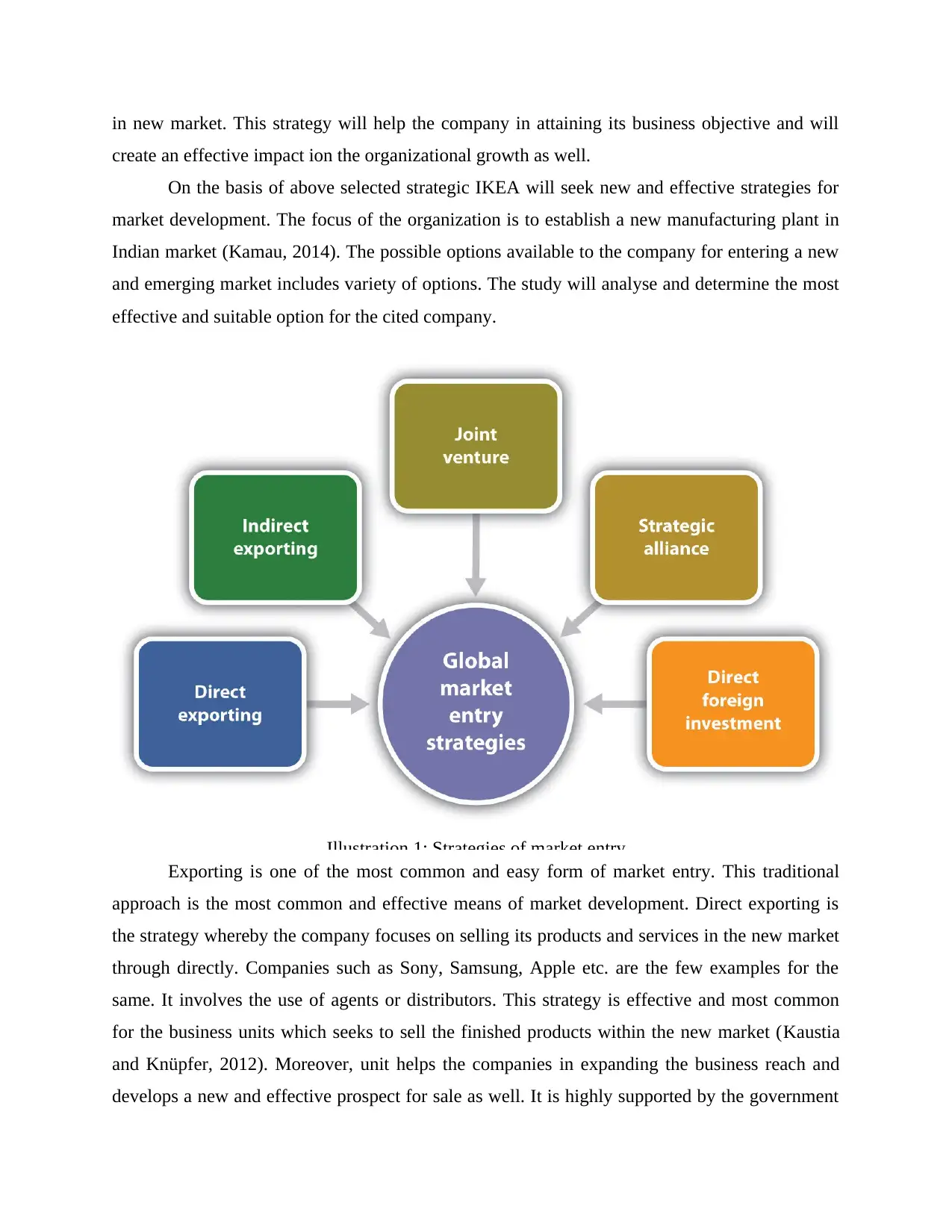
in new market. This strategy will help the company in attaining its business objective and will
create an effective impact ion the organizational growth as well.
On the basis of above selected strategic IKEA will seek new and effective strategies for
market development. The focus of the organization is to establish a new manufacturing plant in
Indian market (Kamau, 2014). The possible options available to the company for entering a new
and emerging market includes variety of options. The study will analyse and determine the most
effective and suitable option for the cited company.
Exporting is one of the most common and easy form of market entry. This traditional
approach is the most common and effective means of market development. Direct exporting is
the strategy whereby the company focuses on selling its products and services in the new market
through directly. Companies such as Sony, Samsung, Apple etc. are the few examples for the
same. It involves the use of agents or distributors. This strategy is effective and most common
for the business units which seeks to sell the finished products within the new market (Kaustia
and Knüpfer, 2012). Moreover, unit helps the companies in expanding the business reach and
develops a new and effective prospect for sale as well. It is highly supported by the government
Illustration 1: Strategies of market entry
create an effective impact ion the organizational growth as well.
On the basis of above selected strategic IKEA will seek new and effective strategies for
market development. The focus of the organization is to establish a new manufacturing plant in
Indian market (Kamau, 2014). The possible options available to the company for entering a new
and emerging market includes variety of options. The study will analyse and determine the most
effective and suitable option for the cited company.
Exporting is one of the most common and easy form of market entry. This traditional
approach is the most common and effective means of market development. Direct exporting is
the strategy whereby the company focuses on selling its products and services in the new market
through directly. Companies such as Sony, Samsung, Apple etc. are the few examples for the
same. It involves the use of agents or distributors. This strategy is effective and most common
for the business units which seeks to sell the finished products within the new market (Kaustia
and Knüpfer, 2012). Moreover, unit helps the companies in expanding the business reach and
develops a new and effective prospect for sale as well. It is highly supported by the government
Illustration 1: Strategies of market entry
Paraphrase This Document
Need a fresh take? Get an instant paraphrase of this document with our AI Paraphraser
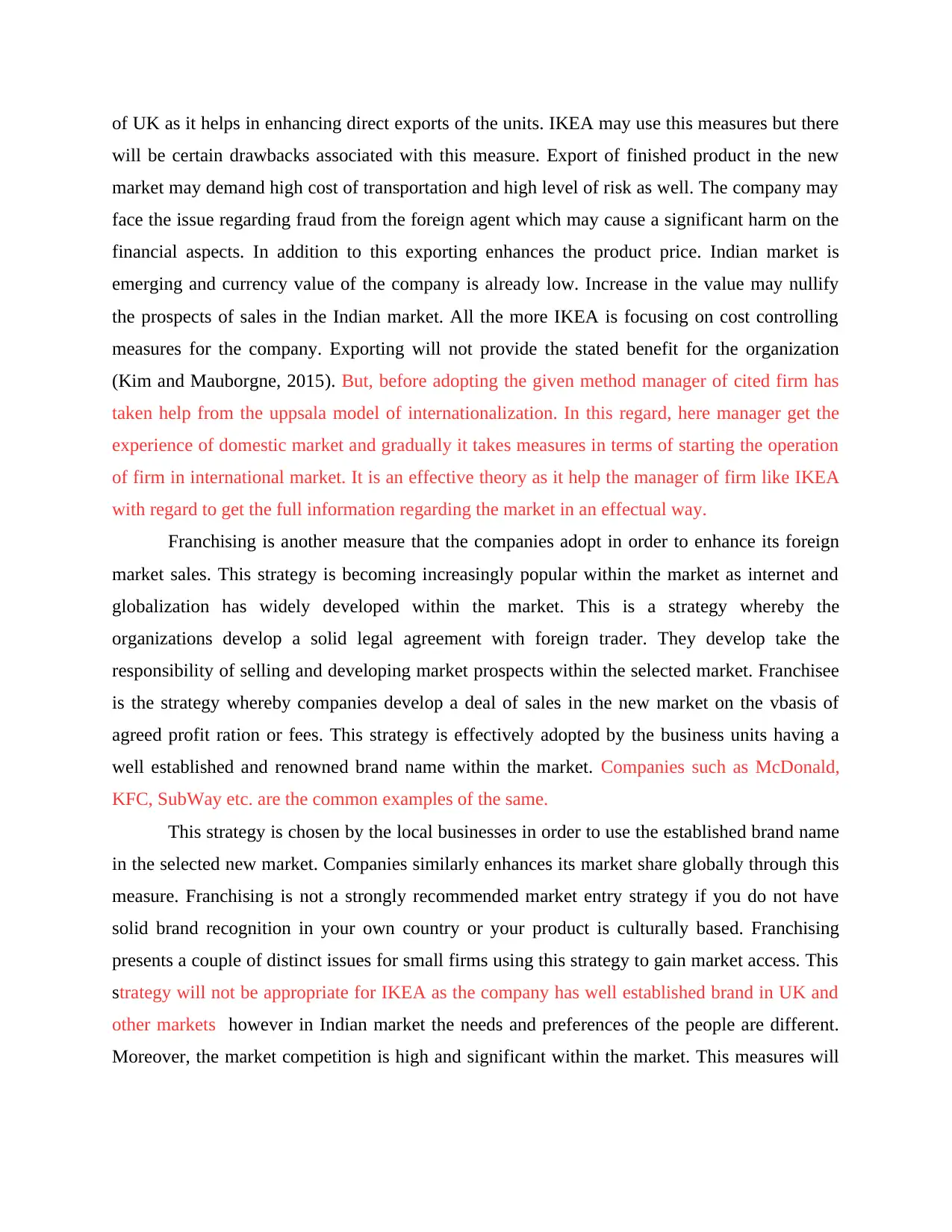
of UK as it helps in enhancing direct exports of the units. IKEA may use this measures but there
will be certain drawbacks associated with this measure. Export of finished product in the new
market may demand high cost of transportation and high level of risk as well. The company may
face the issue regarding fraud from the foreign agent which may cause a significant harm on the
financial aspects. In addition to this exporting enhances the product price. Indian market is
emerging and currency value of the company is already low. Increase in the value may nullify
the prospects of sales in the Indian market. All the more IKEA is focusing on cost controlling
measures for the company. Exporting will not provide the stated benefit for the organization
(Kim and Mauborgne, 2015). But, before adopting the given method manager of cited firm has
taken help from the uppsala model of internationalization. In this regard, here manager get the
experience of domestic market and gradually it takes measures in terms of starting the operation
of firm in international market. It is an effective theory as it help the manager of firm like IKEA
with regard to get the full information regarding the market in an effectual way.
Franchising is another measure that the companies adopt in order to enhance its foreign
market sales. This strategy is becoming increasingly popular within the market as internet and
globalization has widely developed within the market. This is a strategy whereby the
organizations develop a solid legal agreement with foreign trader. They develop take the
responsibility of selling and developing market prospects within the selected market. Franchisee
is the strategy whereby companies develop a deal of sales in the new market on the vbasis of
agreed profit ration or fees. This strategy is effectively adopted by the business units having a
well established and renowned brand name within the market. Companies such as McDonald,
KFC, SubWay etc. are the common examples of the same.
This strategy is chosen by the local businesses in order to use the established brand name
in the selected new market. Companies similarly enhances its market share globally through this
measure. Franchising is not a strongly recommended market entry strategy if you do not have
solid brand recognition in your own country or your product is culturally based. Franchising
presents a couple of distinct issues for small firms using this strategy to gain market access. This
strategy will not be appropriate for IKEA as the company has well established brand in UK and
other markets however in Indian market the needs and preferences of the people are different.
Moreover, the market competition is high and significant within the market. This measures will
will be certain drawbacks associated with this measure. Export of finished product in the new
market may demand high cost of transportation and high level of risk as well. The company may
face the issue regarding fraud from the foreign agent which may cause a significant harm on the
financial aspects. In addition to this exporting enhances the product price. Indian market is
emerging and currency value of the company is already low. Increase in the value may nullify
the prospects of sales in the Indian market. All the more IKEA is focusing on cost controlling
measures for the company. Exporting will not provide the stated benefit for the organization
(Kim and Mauborgne, 2015). But, before adopting the given method manager of cited firm has
taken help from the uppsala model of internationalization. In this regard, here manager get the
experience of domestic market and gradually it takes measures in terms of starting the operation
of firm in international market. It is an effective theory as it help the manager of firm like IKEA
with regard to get the full information regarding the market in an effectual way.
Franchising is another measure that the companies adopt in order to enhance its foreign
market sales. This strategy is becoming increasingly popular within the market as internet and
globalization has widely developed within the market. This is a strategy whereby the
organizations develop a solid legal agreement with foreign trader. They develop take the
responsibility of selling and developing market prospects within the selected market. Franchisee
is the strategy whereby companies develop a deal of sales in the new market on the vbasis of
agreed profit ration or fees. This strategy is effectively adopted by the business units having a
well established and renowned brand name within the market. Companies such as McDonald,
KFC, SubWay etc. are the common examples of the same.
This strategy is chosen by the local businesses in order to use the established brand name
in the selected new market. Companies similarly enhances its market share globally through this
measure. Franchising is not a strongly recommended market entry strategy if you do not have
solid brand recognition in your own country or your product is culturally based. Franchising
presents a couple of distinct issues for small firms using this strategy to gain market access. This
strategy will not be appropriate for IKEA as the company has well established brand in UK and
other markets however in Indian market the needs and preferences of the people are different.
Moreover, the market competition is high and significant within the market. This measures will
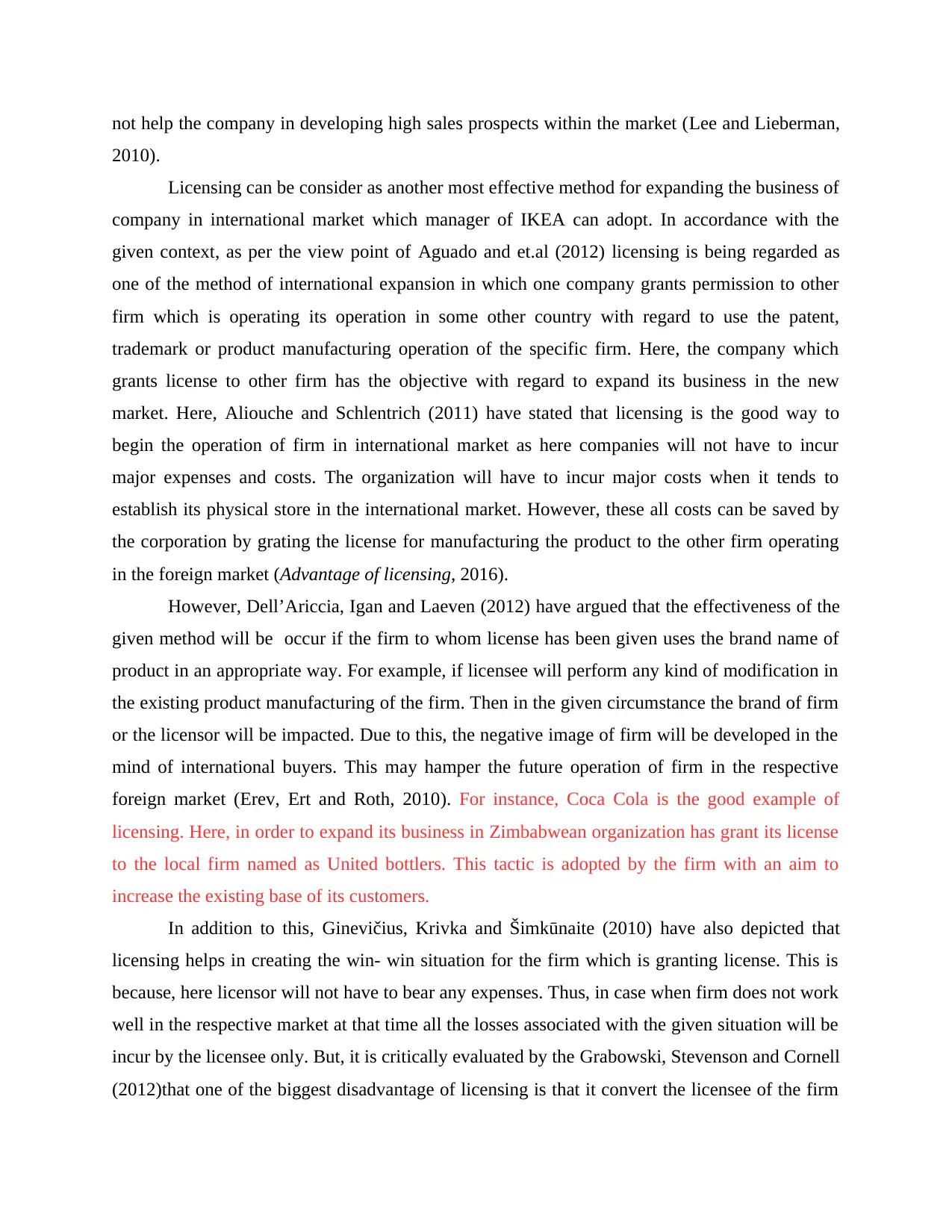
not help the company in developing high sales prospects within the market (Lee and Lieberman,
2010).
Licensing can be consider as another most effective method for expanding the business of
company in international market which manager of IKEA can adopt. In accordance with the
given context, as per the view point of Aguado and et.al (2012) licensing is being regarded as
one of the method of international expansion in which one company grants permission to other
firm which is operating its operation in some other country with regard to use the patent,
trademark or product manufacturing operation of the specific firm. Here, the company which
grants license to other firm has the objective with regard to expand its business in the new
market. Here, Aliouche and Schlentrich (2011) have stated that licensing is the good way to
begin the operation of firm in international market as here companies will not have to incur
major expenses and costs. The organization will have to incur major costs when it tends to
establish its physical store in the international market. However, these all costs can be saved by
the corporation by grating the license for manufacturing the product to the other firm operating
in the foreign market (Advantage of licensing, 2016).
However, Dell’Ariccia, Igan and Laeven (2012) have argued that the effectiveness of the
given method will be occur if the firm to whom license has been given uses the brand name of
product in an appropriate way. For example, if licensee will perform any kind of modification in
the existing product manufacturing of the firm. Then in the given circumstance the brand of firm
or the licensor will be impacted. Due to this, the negative image of firm will be developed in the
mind of international buyers. This may hamper the future operation of firm in the respective
foreign market (Erev, Ert and Roth, 2010). For instance, Coca Cola is the good example of
licensing. Here, in order to expand its business in Zimbabwean organization has grant its license
to the local firm named as United bottlers. This tactic is adopted by the firm with an aim to
increase the existing base of its customers.
In addition to this, Ginevičius, Krivka and Šimkūnaite (2010) have also depicted that
licensing helps in creating the win- win situation for the firm which is granting license. This is
because, here licensor will not have to bear any expenses. Thus, in case when firm does not work
well in the respective market at that time all the losses associated with the given situation will be
incur by the licensee only. But, it is critically evaluated by the Grabowski, Stevenson and Cornell
(2012)that one of the biggest disadvantage of licensing is that it convert the licensee of the firm
2010).
Licensing can be consider as another most effective method for expanding the business of
company in international market which manager of IKEA can adopt. In accordance with the
given context, as per the view point of Aguado and et.al (2012) licensing is being regarded as
one of the method of international expansion in which one company grants permission to other
firm which is operating its operation in some other country with regard to use the patent,
trademark or product manufacturing operation of the specific firm. Here, the company which
grants license to other firm has the objective with regard to expand its business in the new
market. Here, Aliouche and Schlentrich (2011) have stated that licensing is the good way to
begin the operation of firm in international market as here companies will not have to incur
major expenses and costs. The organization will have to incur major costs when it tends to
establish its physical store in the international market. However, these all costs can be saved by
the corporation by grating the license for manufacturing the product to the other firm operating
in the foreign market (Advantage of licensing, 2016).
However, Dell’Ariccia, Igan and Laeven (2012) have argued that the effectiveness of the
given method will be occur if the firm to whom license has been given uses the brand name of
product in an appropriate way. For example, if licensee will perform any kind of modification in
the existing product manufacturing of the firm. Then in the given circumstance the brand of firm
or the licensor will be impacted. Due to this, the negative image of firm will be developed in the
mind of international buyers. This may hamper the future operation of firm in the respective
foreign market (Erev, Ert and Roth, 2010). For instance, Coca Cola is the good example of
licensing. Here, in order to expand its business in Zimbabwean organization has grant its license
to the local firm named as United bottlers. This tactic is adopted by the firm with an aim to
increase the existing base of its customers.
In addition to this, Ginevičius, Krivka and Šimkūnaite (2010) have also depicted that
licensing helps in creating the win- win situation for the firm which is granting license. This is
because, here licensor will not have to bear any expenses. Thus, in case when firm does not work
well in the respective market at that time all the losses associated with the given situation will be
incur by the licensee only. But, it is critically evaluated by the Grabowski, Stevenson and Cornell
(2012)that one of the biggest disadvantage of licensing is that it convert the licensee of the firm
You're viewing a preview
Unlock full access by subscribing today!
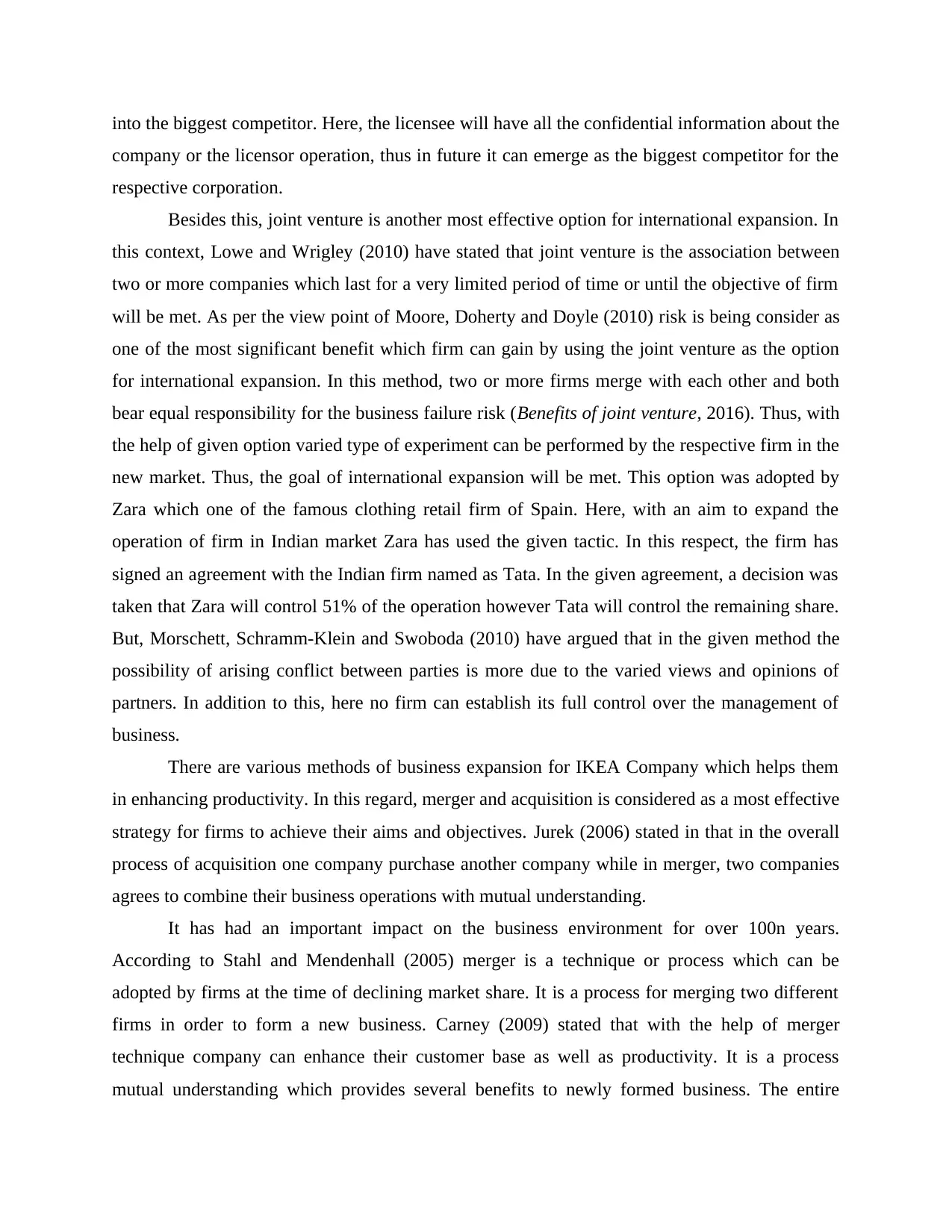
into the biggest competitor. Here, the licensee will have all the confidential information about the
company or the licensor operation, thus in future it can emerge as the biggest competitor for the
respective corporation.
Besides this, joint venture is another most effective option for international expansion. In
this context, Lowe and Wrigley (2010) have stated that joint venture is the association between
two or more companies which last for a very limited period of time or until the objective of firm
will be met. As per the view point of Moore, Doherty and Doyle (2010) risk is being consider as
one of the most significant benefit which firm can gain by using the joint venture as the option
for international expansion. In this method, two or more firms merge with each other and both
bear equal responsibility for the business failure risk (Benefits of joint venture, 2016). Thus, with
the help of given option varied type of experiment can be performed by the respective firm in the
new market. Thus, the goal of international expansion will be met. This option was adopted by
Zara which one of the famous clothing retail firm of Spain. Here, with an aim to expand the
operation of firm in Indian market Zara has used the given tactic. In this respect, the firm has
signed an agreement with the Indian firm named as Tata. In the given agreement, a decision was
taken that Zara will control 51% of the operation however Tata will control the remaining share.
But, Morschett, Schramm-Klein and Swoboda (2010) have argued that in the given method the
possibility of arising conflict between parties is more due to the varied views and opinions of
partners. In addition to this, here no firm can establish its full control over the management of
business.
There are various methods of business expansion for IKEA Company which helps them
in enhancing productivity. In this regard, merger and acquisition is considered as a most effective
strategy for firms to achieve their aims and objectives. Jurek (2006) stated in that in the overall
process of acquisition one company purchase another company while in merger, two companies
agrees to combine their business operations with mutual understanding.
It has had an important impact on the business environment for over 100n years.
According to Stahl and Mendenhall (2005) merger is a technique or process which can be
adopted by firms at the time of declining market share. It is a process for merging two different
firms in order to form a new business. Carney (2009) stated that with the help of merger
technique company can enhance their customer base as well as productivity. It is a process
mutual understanding which provides several benefits to newly formed business. The entire
company or the licensor operation, thus in future it can emerge as the biggest competitor for the
respective corporation.
Besides this, joint venture is another most effective option for international expansion. In
this context, Lowe and Wrigley (2010) have stated that joint venture is the association between
two or more companies which last for a very limited period of time or until the objective of firm
will be met. As per the view point of Moore, Doherty and Doyle (2010) risk is being consider as
one of the most significant benefit which firm can gain by using the joint venture as the option
for international expansion. In this method, two or more firms merge with each other and both
bear equal responsibility for the business failure risk (Benefits of joint venture, 2016). Thus, with
the help of given option varied type of experiment can be performed by the respective firm in the
new market. Thus, the goal of international expansion will be met. This option was adopted by
Zara which one of the famous clothing retail firm of Spain. Here, with an aim to expand the
operation of firm in Indian market Zara has used the given tactic. In this respect, the firm has
signed an agreement with the Indian firm named as Tata. In the given agreement, a decision was
taken that Zara will control 51% of the operation however Tata will control the remaining share.
But, Morschett, Schramm-Klein and Swoboda (2010) have argued that in the given method the
possibility of arising conflict between parties is more due to the varied views and opinions of
partners. In addition to this, here no firm can establish its full control over the management of
business.
There are various methods of business expansion for IKEA Company which helps them
in enhancing productivity. In this regard, merger and acquisition is considered as a most effective
strategy for firms to achieve their aims and objectives. Jurek (2006) stated in that in the overall
process of acquisition one company purchase another company while in merger, two companies
agrees to combine their business operations with mutual understanding.
It has had an important impact on the business environment for over 100n years.
According to Stahl and Mendenhall (2005) merger is a technique or process which can be
adopted by firms at the time of declining market share. It is a process for merging two different
firms in order to form a new business. Carney (2009) stated that with the help of merger
technique company can enhance their customer base as well as productivity. It is a process
mutual understanding which provides several benefits to newly formed business. The entire
Paraphrase This Document
Need a fresh take? Get an instant paraphrase of this document with our AI Paraphraser
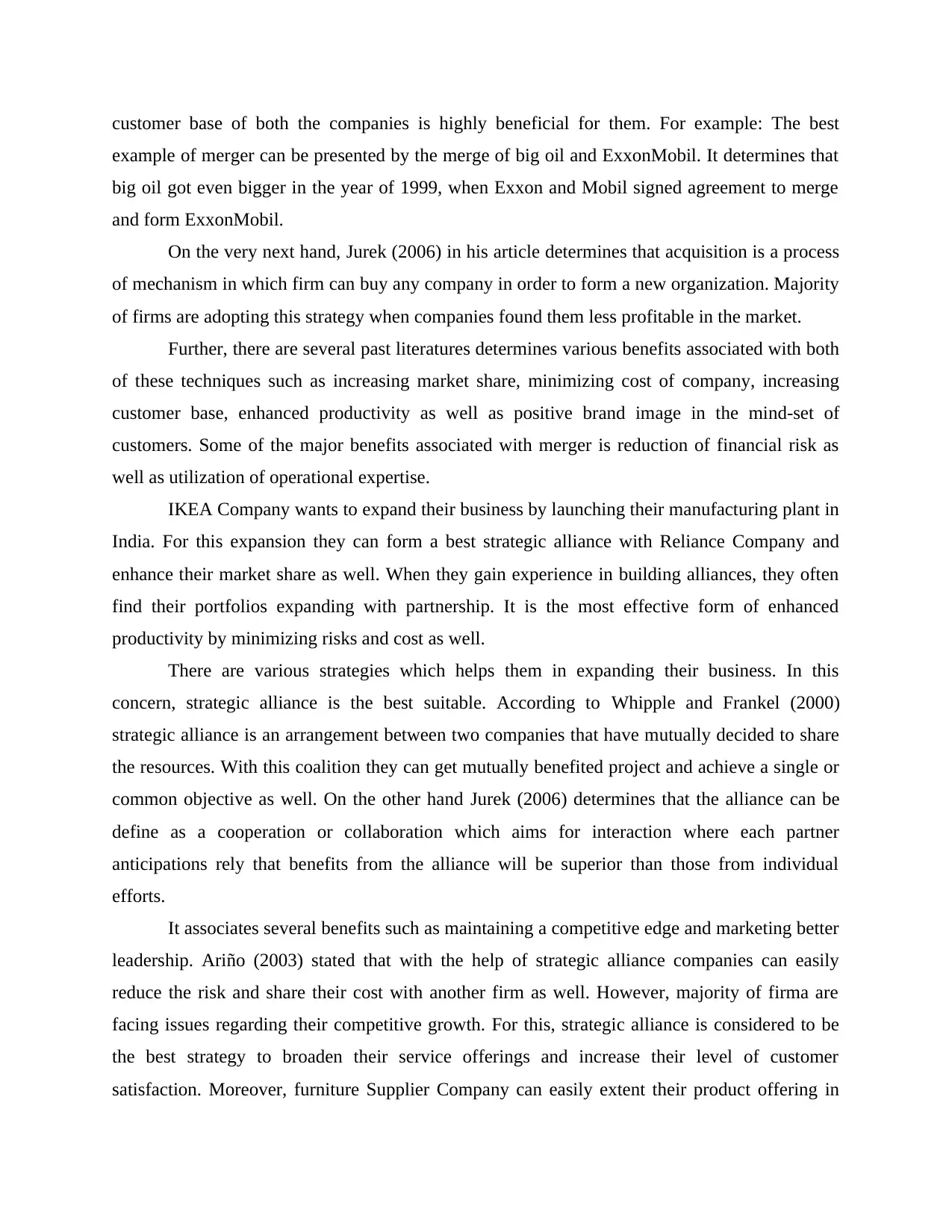
customer base of both the companies is highly beneficial for them. For example: The best
example of merger can be presented by the merge of big oil and ExxonMobil. It determines that
big oil got even bigger in the year of 1999, when Exxon and Mobil signed agreement to merge
and form ExxonMobil.
On the very next hand, Jurek (2006) in his article determines that acquisition is a process
of mechanism in which firm can buy any company in order to form a new organization. Majority
of firms are adopting this strategy when companies found them less profitable in the market.
Further, there are several past literatures determines various benefits associated with both
of these techniques such as increasing market share, minimizing cost of company, increasing
customer base, enhanced productivity as well as positive brand image in the mind-set of
customers. Some of the major benefits associated with merger is reduction of financial risk as
well as utilization of operational expertise.
IKEA Company wants to expand their business by launching their manufacturing plant in
India. For this expansion they can form a best strategic alliance with Reliance Company and
enhance their market share as well. When they gain experience in building alliances, they often
find their portfolios expanding with partnership. It is the most effective form of enhanced
productivity by minimizing risks and cost as well.
There are various strategies which helps them in expanding their business. In this
concern, strategic alliance is the best suitable. According to Whipple and Frankel (2000)
strategic alliance is an arrangement between two companies that have mutually decided to share
the resources. With this coalition they can get mutually benefited project and achieve a single or
common objective as well. On the other hand Jurek (2006) determines that the alliance can be
define as a cooperation or collaboration which aims for interaction where each partner
anticipations rely that benefits from the alliance will be superior than those from individual
efforts.
It associates several benefits such as maintaining a competitive edge and marketing better
leadership. Ariño (2003) stated that with the help of strategic alliance companies can easily
reduce the risk and share their cost with another firm as well. However, majority of firma are
facing issues regarding their competitive growth. For this, strategic alliance is considered to be
the best strategy to broaden their service offerings and increase their level of customer
satisfaction. Moreover, furniture Supplier Company can easily extent their product offering in
example of merger can be presented by the merge of big oil and ExxonMobil. It determines that
big oil got even bigger in the year of 1999, when Exxon and Mobil signed agreement to merge
and form ExxonMobil.
On the very next hand, Jurek (2006) in his article determines that acquisition is a process
of mechanism in which firm can buy any company in order to form a new organization. Majority
of firms are adopting this strategy when companies found them less profitable in the market.
Further, there are several past literatures determines various benefits associated with both
of these techniques such as increasing market share, minimizing cost of company, increasing
customer base, enhanced productivity as well as positive brand image in the mind-set of
customers. Some of the major benefits associated with merger is reduction of financial risk as
well as utilization of operational expertise.
IKEA Company wants to expand their business by launching their manufacturing plant in
India. For this expansion they can form a best strategic alliance with Reliance Company and
enhance their market share as well. When they gain experience in building alliances, they often
find their portfolios expanding with partnership. It is the most effective form of enhanced
productivity by minimizing risks and cost as well.
There are various strategies which helps them in expanding their business. In this
concern, strategic alliance is the best suitable. According to Whipple and Frankel (2000)
strategic alliance is an arrangement between two companies that have mutually decided to share
the resources. With this coalition they can get mutually benefited project and achieve a single or
common objective as well. On the other hand Jurek (2006) determines that the alliance can be
define as a cooperation or collaboration which aims for interaction where each partner
anticipations rely that benefits from the alliance will be superior than those from individual
efforts.
It associates several benefits such as maintaining a competitive edge and marketing better
leadership. Ariño (2003) stated that with the help of strategic alliance companies can easily
reduce the risk and share their cost with another firm as well. However, majority of firma are
facing issues regarding their competitive growth. For this, strategic alliance is considered to be
the best strategy to broaden their service offerings and increase their level of customer
satisfaction. Moreover, furniture Supplier Company can easily extent their product offering in
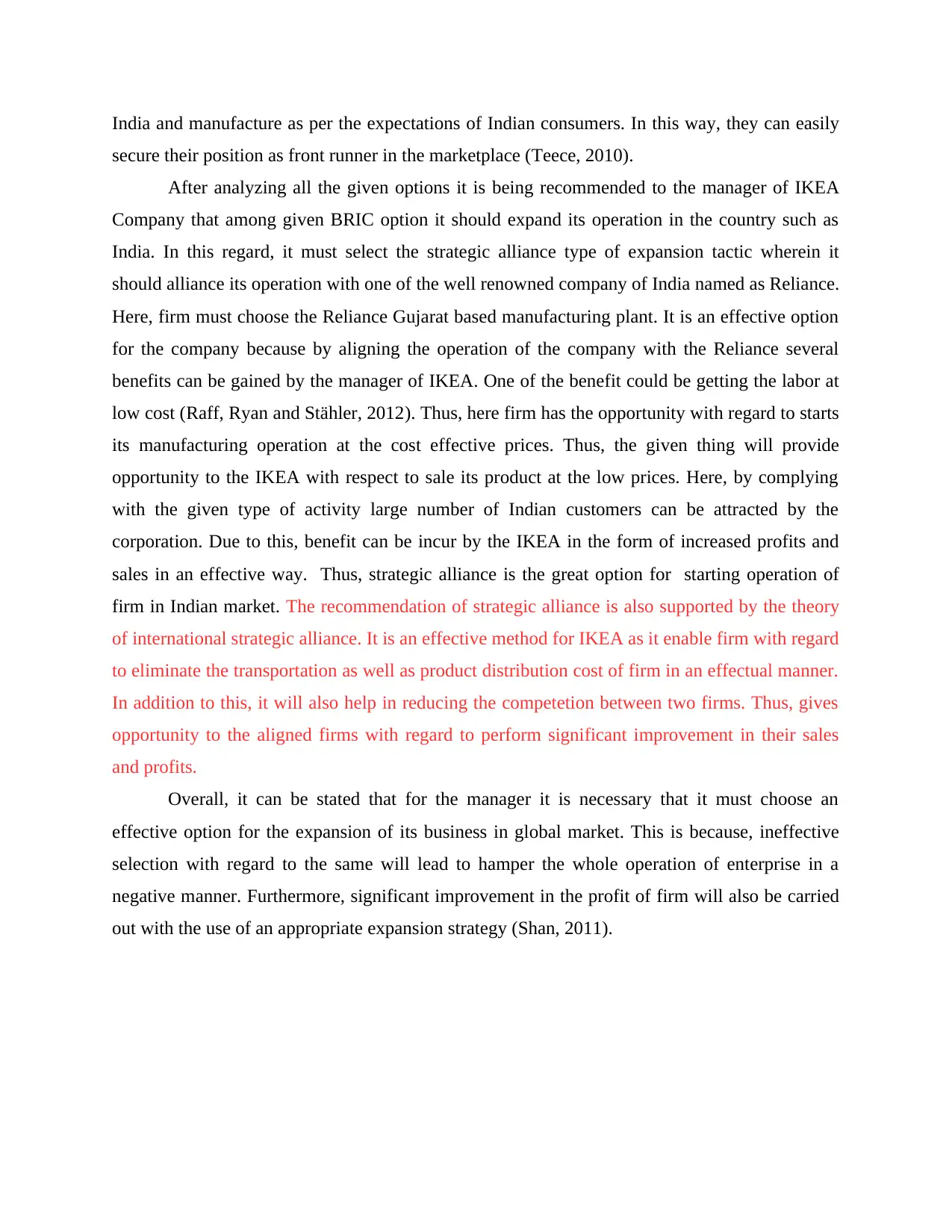
India and manufacture as per the expectations of Indian consumers. In this way, they can easily
secure their position as front runner in the marketplace (Teece, 2010).
After analyzing all the given options it is being recommended to the manager of IKEA
Company that among given BRIC option it should expand its operation in the country such as
India. In this regard, it must select the strategic alliance type of expansion tactic wherein it
should alliance its operation with one of the well renowned company of India named as Reliance.
Here, firm must choose the Reliance Gujarat based manufacturing plant. It is an effective option
for the company because by aligning the operation of the company with the Reliance several
benefits can be gained by the manager of IKEA. One of the benefit could be getting the labor at
low cost (Raff, Ryan and Stähler, 2012). Thus, here firm has the opportunity with regard to starts
its manufacturing operation at the cost effective prices. Thus, the given thing will provide
opportunity to the IKEA with respect to sale its product at the low prices. Here, by complying
with the given type of activity large number of Indian customers can be attracted by the
corporation. Due to this, benefit can be incur by the IKEA in the form of increased profits and
sales in an effective way. Thus, strategic alliance is the great option for starting operation of
firm in Indian market. The recommendation of strategic alliance is also supported by the theory
of international strategic alliance. It is an effective method for IKEA as it enable firm with regard
to eliminate the transportation as well as product distribution cost of firm in an effectual manner.
In addition to this, it will also help in reducing the competetion between two firms. Thus, gives
opportunity to the aligned firms with regard to perform significant improvement in their sales
and profits.
Overall, it can be stated that for the manager it is necessary that it must choose an
effective option for the expansion of its business in global market. This is because, ineffective
selection with regard to the same will lead to hamper the whole operation of enterprise in a
negative manner. Furthermore, significant improvement in the profit of firm will also be carried
out with the use of an appropriate expansion strategy (Shan, 2011).
secure their position as front runner in the marketplace (Teece, 2010).
After analyzing all the given options it is being recommended to the manager of IKEA
Company that among given BRIC option it should expand its operation in the country such as
India. In this regard, it must select the strategic alliance type of expansion tactic wherein it
should alliance its operation with one of the well renowned company of India named as Reliance.
Here, firm must choose the Reliance Gujarat based manufacturing plant. It is an effective option
for the company because by aligning the operation of the company with the Reliance several
benefits can be gained by the manager of IKEA. One of the benefit could be getting the labor at
low cost (Raff, Ryan and Stähler, 2012). Thus, here firm has the opportunity with regard to starts
its manufacturing operation at the cost effective prices. Thus, the given thing will provide
opportunity to the IKEA with respect to sale its product at the low prices. Here, by complying
with the given type of activity large number of Indian customers can be attracted by the
corporation. Due to this, benefit can be incur by the IKEA in the form of increased profits and
sales in an effective way. Thus, strategic alliance is the great option for starting operation of
firm in Indian market. The recommendation of strategic alliance is also supported by the theory
of international strategic alliance. It is an effective method for IKEA as it enable firm with regard
to eliminate the transportation as well as product distribution cost of firm in an effectual manner.
In addition to this, it will also help in reducing the competetion between two firms. Thus, gives
opportunity to the aligned firms with regard to perform significant improvement in their sales
and profits.
Overall, it can be stated that for the manager it is necessary that it must choose an
effective option for the expansion of its business in global market. This is because, ineffective
selection with regard to the same will lead to hamper the whole operation of enterprise in a
negative manner. Furthermore, significant improvement in the profit of firm will also be carried
out with the use of an appropriate expansion strategy (Shan, 2011).
You're viewing a preview
Unlock full access by subscribing today!
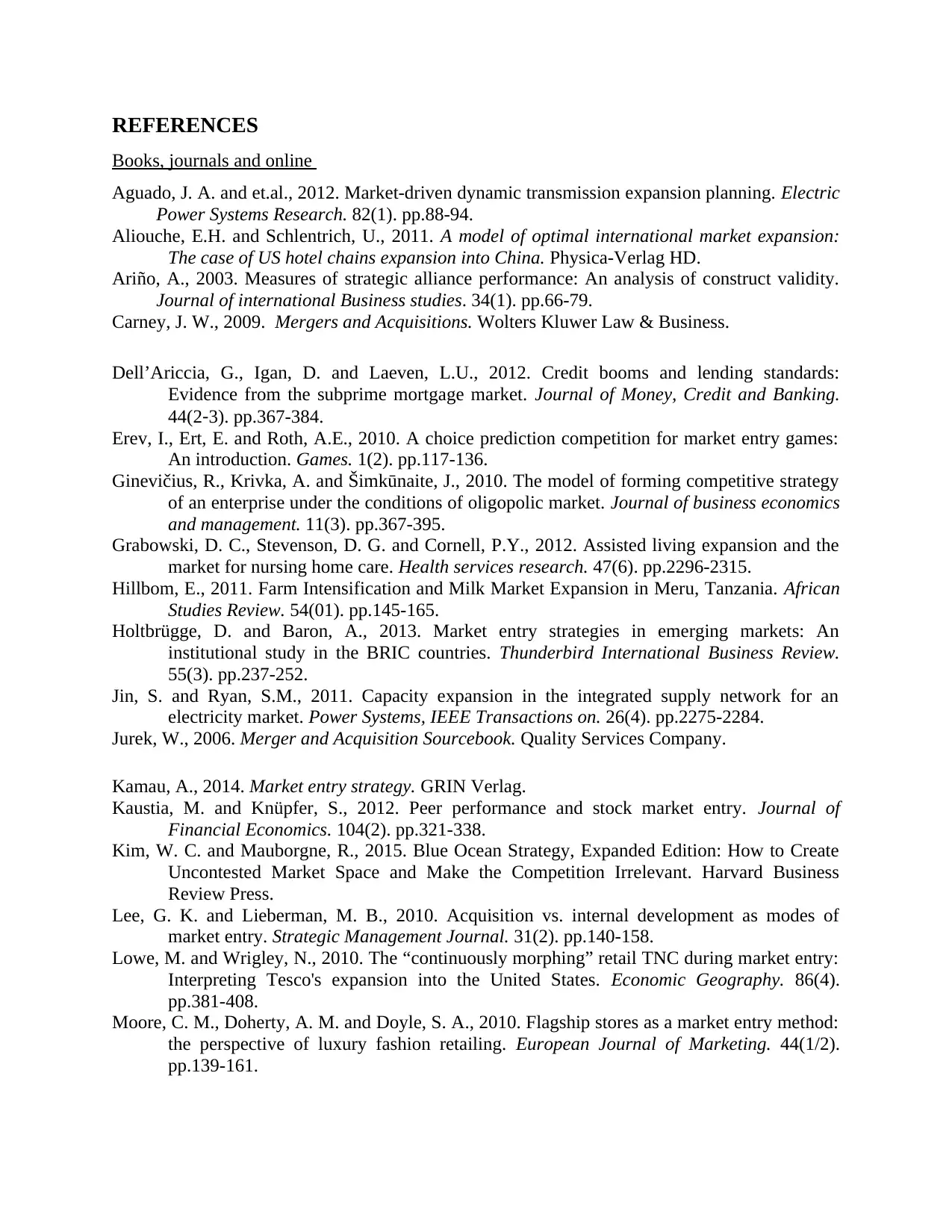
REFERENCES
Books, journals and online
Aguado, J. A. and et.al., 2012. Market-driven dynamic transmission expansion planning. Electric
Power Systems Research. 82(1). pp.88-94.
Aliouche, E.H. and Schlentrich, U., 2011. A model of optimal international market expansion:
The case of US hotel chains expansion into China. Physica-Verlag HD.
Ariño, A., 2003. Measures of strategic alliance performance: An analysis of construct validity.
Journal of international Business studies. 34(1). pp.66-79.
Carney, J. W., 2009. Mergers and Acquisitions. Wolters Kluwer Law & Business.
Dell’Ariccia, G., Igan, D. and Laeven, L.U., 2012. Credit booms and lending standards:
Evidence from the subprime mortgage market. Journal of Money, Credit and Banking.
44(2‐3). pp.367-384.
Erev, I., Ert, E. and Roth, A.E., 2010. A choice prediction competition for market entry games:
An introduction. Games. 1(2). pp.117-136.
Ginevičius, R., Krivka, A. and Šimkūnaite, J., 2010. The model of forming competitive strategy
of an enterprise under the conditions of oligopolic market. Journal of business economics
and management. 11(3). pp.367-395.
Grabowski, D. C., Stevenson, D. G. and Cornell, P.Y., 2012. Assisted living expansion and the
market for nursing home care. Health services research. 47(6). pp.2296-2315.
Hillbom, E., 2011. Farm Intensification and Milk Market Expansion in Meru, Tanzania. African
Studies Review. 54(01). pp.145-165.
Holtbrügge, D. and Baron, A., 2013. Market entry strategies in emerging markets: An
institutional study in the BRIC countries. Thunderbird International Business Review.
55(3). pp.237-252.
Jin, S. and Ryan, S.M., 2011. Capacity expansion in the integrated supply network for an
electricity market. Power Systems, IEEE Transactions on. 26(4). pp.2275-2284.
Jurek, W., 2006. Merger and Acquisition Sourcebook. Quality Services Company.
Kamau, A., 2014. Market entry strategy. GRIN Verlag.
Kaustia, M. and Knüpfer, S., 2012. Peer performance and stock market entry. Journal of
Financial Economics. 104(2). pp.321-338.
Kim, W. C. and Mauborgne, R., 2015. Blue Ocean Strategy, Expanded Edition: How to Create
Uncontested Market Space and Make the Competition Irrelevant. Harvard Business
Review Press.
Lee, G. K. and Lieberman, M. B., 2010. Acquisition vs. internal development as modes of
market entry. Strategic Management Journal. 31(2). pp.140-158.
Lowe, M. and Wrigley, N., 2010. The “continuously morphing” retail TNC during market entry:
Interpreting Tesco's expansion into the United States. Economic Geography. 86(4).
pp.381-408.
Moore, C. M., Doherty, A. M. and Doyle, S. A., 2010. Flagship stores as a market entry method:
the perspective of luxury fashion retailing. European Journal of Marketing. 44(1/2).
pp.139-161.
Books, journals and online
Aguado, J. A. and et.al., 2012. Market-driven dynamic transmission expansion planning. Electric
Power Systems Research. 82(1). pp.88-94.
Aliouche, E.H. and Schlentrich, U., 2011. A model of optimal international market expansion:
The case of US hotel chains expansion into China. Physica-Verlag HD.
Ariño, A., 2003. Measures of strategic alliance performance: An analysis of construct validity.
Journal of international Business studies. 34(1). pp.66-79.
Carney, J. W., 2009. Mergers and Acquisitions. Wolters Kluwer Law & Business.
Dell’Ariccia, G., Igan, D. and Laeven, L.U., 2012. Credit booms and lending standards:
Evidence from the subprime mortgage market. Journal of Money, Credit and Banking.
44(2‐3). pp.367-384.
Erev, I., Ert, E. and Roth, A.E., 2010. A choice prediction competition for market entry games:
An introduction. Games. 1(2). pp.117-136.
Ginevičius, R., Krivka, A. and Šimkūnaite, J., 2010. The model of forming competitive strategy
of an enterprise under the conditions of oligopolic market. Journal of business economics
and management. 11(3). pp.367-395.
Grabowski, D. C., Stevenson, D. G. and Cornell, P.Y., 2012. Assisted living expansion and the
market for nursing home care. Health services research. 47(6). pp.2296-2315.
Hillbom, E., 2011. Farm Intensification and Milk Market Expansion in Meru, Tanzania. African
Studies Review. 54(01). pp.145-165.
Holtbrügge, D. and Baron, A., 2013. Market entry strategies in emerging markets: An
institutional study in the BRIC countries. Thunderbird International Business Review.
55(3). pp.237-252.
Jin, S. and Ryan, S.M., 2011. Capacity expansion in the integrated supply network for an
electricity market. Power Systems, IEEE Transactions on. 26(4). pp.2275-2284.
Jurek, W., 2006. Merger and Acquisition Sourcebook. Quality Services Company.
Kamau, A., 2014. Market entry strategy. GRIN Verlag.
Kaustia, M. and Knüpfer, S., 2012. Peer performance and stock market entry. Journal of
Financial Economics. 104(2). pp.321-338.
Kim, W. C. and Mauborgne, R., 2015. Blue Ocean Strategy, Expanded Edition: How to Create
Uncontested Market Space and Make the Competition Irrelevant. Harvard Business
Review Press.
Lee, G. K. and Lieberman, M. B., 2010. Acquisition vs. internal development as modes of
market entry. Strategic Management Journal. 31(2). pp.140-158.
Lowe, M. and Wrigley, N., 2010. The “continuously morphing” retail TNC during market entry:
Interpreting Tesco's expansion into the United States. Economic Geography. 86(4).
pp.381-408.
Moore, C. M., Doherty, A. M. and Doyle, S. A., 2010. Flagship stores as a market entry method:
the perspective of luxury fashion retailing. European Journal of Marketing. 44(1/2).
pp.139-161.
Paraphrase This Document
Need a fresh take? Get an instant paraphrase of this document with our AI Paraphraser
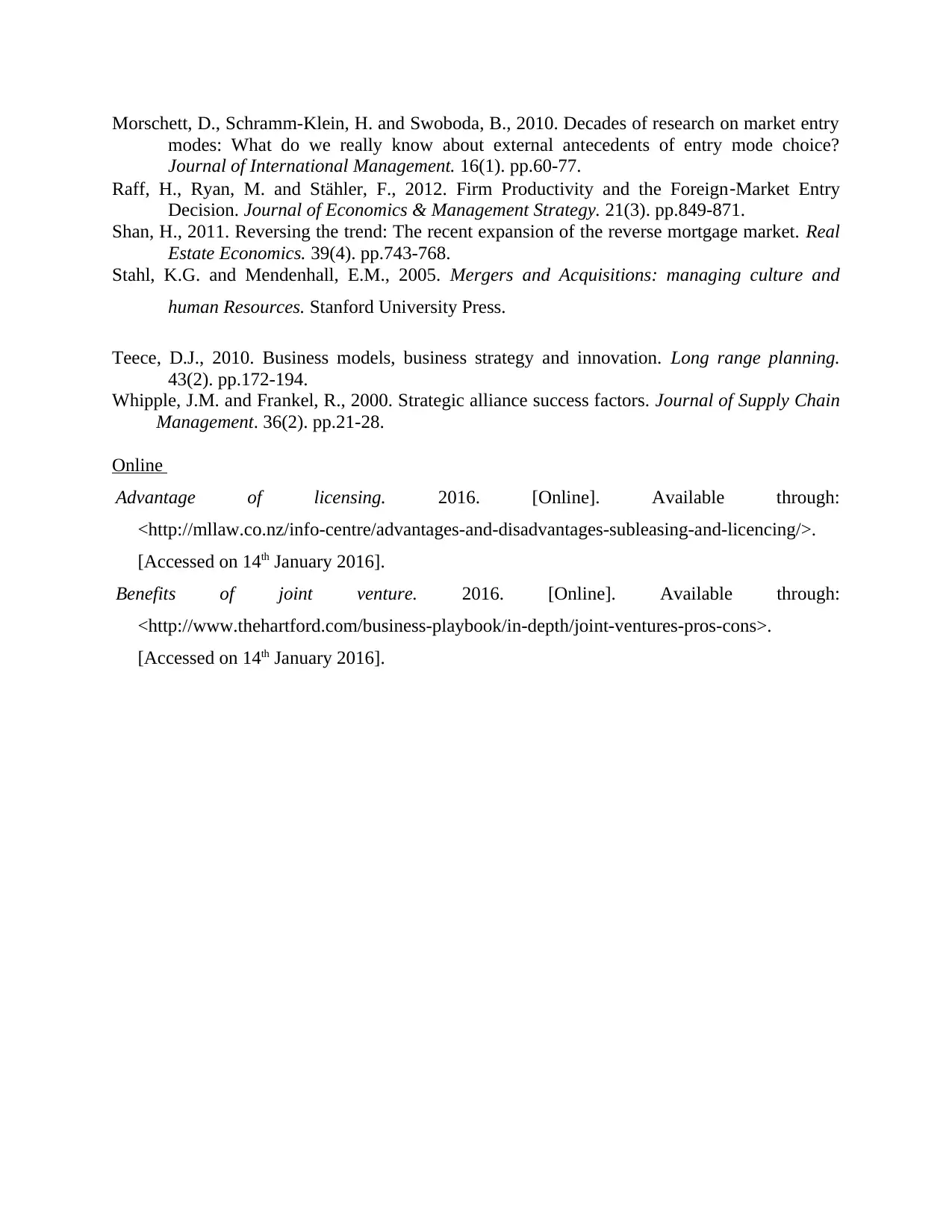
Morschett, D., Schramm-Klein, H. and Swoboda, B., 2010. Decades of research on market entry
modes: What do we really know about external antecedents of entry mode choice?
Journal of International Management. 16(1). pp.60-77.
Raff, H., Ryan, M. and Stähler, F., 2012. Firm Productivity and the Foreign‐Market Entry
Decision. Journal of Economics & Management Strategy. 21(3). pp.849-871.
Shan, H., 2011. Reversing the trend: The recent expansion of the reverse mortgage market. Real
Estate Economics. 39(4). pp.743-768.
Stahl, K.G. and Mendenhall, E.M., 2005. Mergers and Acquisitions: managing culture and
human Resources. Stanford University Press.
Teece, D.J., 2010. Business models, business strategy and innovation. Long range planning.
43(2). pp.172-194.
Whipple, J.M. and Frankel, R., 2000. Strategic alliance success factors. Journal of Supply Chain
Management. 36(2). pp.21-28.
Online
Advantage of licensing. 2016. [Online]. Available through:
<http://mllaw.co.nz/info-centre/advantages-and-disadvantages-subleasing-and-licencing/>.
[Accessed on 14th January 2016].
Benefits of joint venture. 2016. [Online]. Available through:
<http://www.thehartford.com/business-playbook/in-depth/joint-ventures-pros-cons>.
[Accessed on 14th January 2016].
modes: What do we really know about external antecedents of entry mode choice?
Journal of International Management. 16(1). pp.60-77.
Raff, H., Ryan, M. and Stähler, F., 2012. Firm Productivity and the Foreign‐Market Entry
Decision. Journal of Economics & Management Strategy. 21(3). pp.849-871.
Shan, H., 2011. Reversing the trend: The recent expansion of the reverse mortgage market. Real
Estate Economics. 39(4). pp.743-768.
Stahl, K.G. and Mendenhall, E.M., 2005. Mergers and Acquisitions: managing culture and
human Resources. Stanford University Press.
Teece, D.J., 2010. Business models, business strategy and innovation. Long range planning.
43(2). pp.172-194.
Whipple, J.M. and Frankel, R., 2000. Strategic alliance success factors. Journal of Supply Chain
Management. 36(2). pp.21-28.
Online
Advantage of licensing. 2016. [Online]. Available through:
<http://mllaw.co.nz/info-centre/advantages-and-disadvantages-subleasing-and-licencing/>.
[Accessed on 14th January 2016].
Benefits of joint venture. 2016. [Online]. Available through:
<http://www.thehartford.com/business-playbook/in-depth/joint-ventures-pros-cons>.
[Accessed on 14th January 2016].
1 out of 11
Related Documents
Your All-in-One AI-Powered Toolkit for Academic Success.
+13062052269
info@desklib.com
Available 24*7 on WhatsApp / Email
![[object Object]](/_next/static/media/star-bottom.7253800d.svg)
Unlock your academic potential
© 2024 | Zucol Services PVT LTD | All rights reserved.





